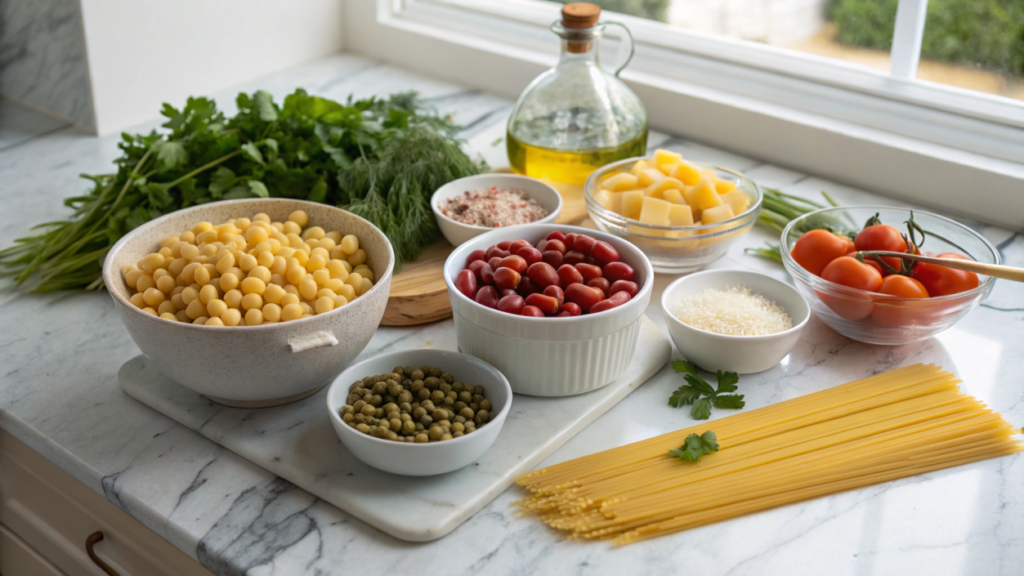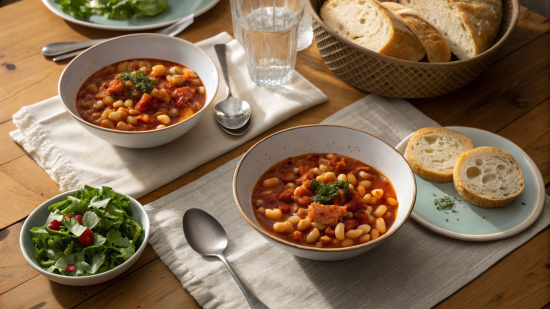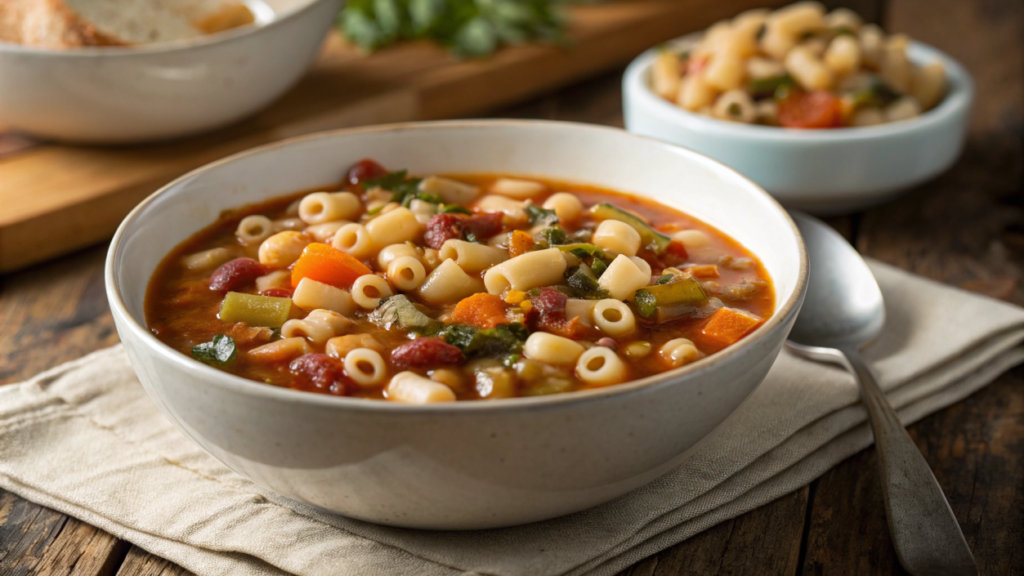Ditalini Pasta Recipe – Why This Recipe?
Hello, fellow food enthusiasts! Chef Greeny here, and today I’m thrilled to share my absolute favorite ditalini pasta recipes with you. These tiny, tube-shaped pasta pieces have been a staple in my kitchen for years, and for good reason. My journey with ditalini began during my first trip to Italy, where I discovered this versatile pasta in a humble trattoria in Naples. The chef served a simple ditalini soup that warmed both body and soul, and I’ve been experimenting with these little pasta tubes ever since.
What makes ditalini so special is its incredible versatility. These small pasta shapes hold up beautifully in soups, work wonderfully in pasta salads, and create the perfect base for hearty one-pot meals. The recipes I’m sharing today include my own unique twists that elevate classic dishes to new heights.
In this comprehensive guide, you’ll learn how to prepare perfect ditalini pasta every time, discover mouthwatering recipes from traditional Italian classics to modern innovations, and gain insights into the nutritional benefits of this delightful pasta. Whether you’re a seasoned chef or a kitchen novice, these ditalini pasta recipes will become treasured additions to your culinary repertoire.
Ditalini Pasta Recipe – Ingredients and Preparation
Ingredients List

For the Classic Ditalini Pasta e Fagioli (Pasta and Beans):
- 2 cups (16 oz) ditalini pasta
- 1 tablespoon olive oil
- 1 medium onion, finely diced
- 2 carrots, peeled and diced
- 2 celery stalks, diced
- 3 cloves garlic, minced
- 1 teaspoon dried oregano
- 1 teaspoon dried basil
- 1/2 teaspoon red pepper flakes (optional)
- 2 cans (15 oz each) cannellini beans, drained and rinsed
- 1 can (14.5 oz) diced tomatoes
- 4 cups vegetable or chicken broth
- 2 bay leaves
- Salt and freshly ground black pepper to taste
- Fresh parsley, chopped, for garnish
- Grated Parmesan cheese (optional)
Substitutions:
- Gluten-free option: Use gluten-free ditalini pasta or substitute with rice
- Vegan option: Use vegetable broth and omit Parmesan cheese or use nutritional yeast instead
- Bean alternatives: Great northern beans or navy beans work well in place of cannellini
Step-by-Step Instructions
- Prepare the base: Heat olive oil in a large pot over medium heat. Add onions, carrots, and celery, and sauté for 5-7 minutes until vegetables begin to soften.
- Chef’s tip: Don’t rush this step – developing flavor in the mirepoix (onion, carrot, celery mix) creates a robust foundation for your soup.
- Add aromatics: Stir in garlic, oregano, basil, and red pepper flakes (if using). Cook for another 30 seconds until fragrant.
- Chef’s tip: Adding dried herbs at this stage helps to “bloom” their flavors in the oil.
- Build the soup: Add cannellini beans, diced tomatoes (with their juice), broth, and bay leaves. Bring to a boil, then reduce heat and simmer for 15-20 minutes until vegetables are tender.
- Chef’s tip: For a creamier texture, mash about 1/3 of the beans before adding them to the pot.
- Cook the pasta: While the soup simmers, cook ditalini pasta in a separate pot according to package directions until al dente, usually 8-10 minutes.
- Chef’s tip: Cooking pasta separately prevents it from absorbing too much liquid and becoming mushy in the soup.
- Combine and serve: Drain the pasta and add it to the soup. Season with salt and pepper to taste. Remove bay leaves before serving.
- Chef’s tip: If making ahead, keep pasta separate and combine only when ready to serve.
- Garnish and enjoy: Ladle into bowls, garnish with fresh parsley and grated Parmesan cheese if desired.
Notes and Tips
Storage:
- Refrigerate leftovers in an airtight container for up to 3-4 days.
- If storing for later, keep pasta separate from soup to prevent it from becoming soggy.
- Freeze without pasta for up to 3 months; add fresh cooked pasta when reheating.
Serving Suggestions:
- Pair with a simple green salad and crusty Italian bread for a complete meal.
- Drizzle high-quality extra virgin olive oil just before serving for an authentic Italian touch.
- For a heartier meal, add cooked Italian sausage or rotisserie chicken.
Make-Ahead Instructions:
- Prepare soup base up to 2 days ahead, refrigerate, and add freshly cooked pasta when ready to serve.
- For meal prep, portion soup base into containers, refrigerate, and cook fresh pasta on the day of serving.
Ditalini Pasta Recipe – Nutritional Information
Nutrition Facts (Per Serving, approximately 1.5 cups)
- Calories: 320
- Carbohydrates: 52g
- Protein: 15g
- Total Fat: 5g
- Saturated Fat: 1g
- Unsaturated Fat: 3.5g
- Trans Fat: 0g
- Fiber: 8g
- Sugar: 4g
- Cholesterol: 0mg (5mg with Parmesan)
- Sodium: 480mg
Note: Nutritional values are approximate and may vary based on specific ingredients and brands used.
My ditalini pasta e fagioli offers an excellent balance of complex carbohydrates and plant-based protein, making it a nutritionally complete meal. The combination of beans and pasta creates a dish that’s satisfying while providing sustained energy. The abundance of vegetables adds essential vitamins, minerals, and dietary fiber, supporting digestive health and contributing to overall wellbeing.
Ditalini Pasta Recipe – History and Cultural Significance

Ditalini pasta, whose name translates to “little thimbles” in Italian, has deep roots in Italian culinary tradition, particularly in the southern regions. These small tube-shaped pasta pieces have been a staple in Italian pantries for generations, especially in Naples and Sicily, where they’re often used in rustic, comforting dishes.
The pasta e fagioli recipe I’ve shared has its origins in cucina povera (“poor kitchen”) cooking – the tradition of creating nourishing, delicious meals from humble, inexpensive ingredients. This approach to cooking emerged from necessity during economic hardships but has endured because of its inherent wisdom in combining simple ingredients to create nutritious, satisfying meals.
Throughout Italy, you’ll find regional variations of dishes featuring ditalini:
- In Naples, it’s often featured in pasta e patate (pasta and potatoes)
- In Sicily, it appears in minestrone variations with local vegetables
- In Rome, you might find it in stracciatella soup with eggs and parmesan
Similar pasta shapes exist worldwide – from tubettini (slightly larger) to anellini (ring-shaped) – but ditalini’s perfect size makes it ideal for soups and light pasta dishes where balance between pasta and other ingredients is crucial.
Ditalini Pasta Recipe – Creative Variations
Mediterranean Ditalini Pasta Salad
Transform ditalini into a refreshing salad perfect for summer gatherings:
Ingredients:
- 2 cups cooked ditalini pasta, cooled
- 1 cup cherry tomatoes, halved
- 1 cucumber, diced
- 1/2 cup Kalamata olives, pitted and halved
- 1/2 red onion, finely diced
- 1 bell pepper, diced
- 1/2 cup crumbled feta cheese
- 1/4 cup fresh basil, chopped
- 3 tablespoons extra virgin olive oil
- 2 tablespoons red wine vinegar
- 1 teaspoon dried oregano
- Salt and pepper to taste
Preparation: Combine all ingredients in a large bowl, toss gently, and refrigerate for at least 30 minutes before serving to allow flavors to meld. Perfect for meal prep lunches or as a side dish.
Creamy Vegan Ditalini with Butternut Squash
A dairy-free comfort food option that’s perfect for fall:
Ingredients:
- 2 cups ditalini pasta
- 2 cups butternut squash, peeled and cubed
- 1 onion, diced
- 3 cloves garlic, minced
- 1 cup unsweetened almond milk
- 2 tablespoons nutritional yeast
- 1 tablespoon olive oil
- 1 teaspoon dried sage
- 1/2 teaspoon nutmeg
- Salt and pepper to taste
- Toasted walnuts and fresh thyme for garnish
Preparation:
- Roast butternut squash with olive oil, salt, and pepper at 400°F for 25 minutes until tender.
- Cook ditalini according to package directions.
- In a blender, combine roasted squash, almond milk, nutritional yeast, sage, and nutmeg until smooth.
- Sauté onion and garlic until translucent, add the squash sauce, then fold in the cooked pasta.
- Garnish with toasted walnuts and fresh thyme before serving.
Tips for Adaptation:
- For gluten-free diets: Substitute gluten-free ditalini or similar small pasta shapes.
- For low-carb options: Reduce pasta quantity and increase vegetables, or try alternative grain pastas like chickpea pasta.
- For protein-rich versions: Add white beans, grilled chicken, or Italian sausage to any of these recipes.
Ditalini Pasta Recipe – Frequently Asked Questions

Can I make ditalini pasta recipes ahead of time?
Yes, most ditalini pasta dishes can be prepared ahead of time, though with some considerations. For soups and stews, I recommend cooking and storing the pasta separately from the liquid base to prevent it from absorbing too much liquid and becoming mushy. When ready to serve, simply combine freshly warmed soup with the pasta. For pasta salads, they actually benefit from being made a few hours or even a day ahead, allowing flavors to develop. Just reserve a little extra dressing to refresh before serving.
What can I substitute for ditalini pasta if I can’t find it?
If ditalini isn’t available, look for tubettini, which is similar but slightly larger. Other good substitutes include small elbow macaroni, orzo, or even small shells (conchigliette). The key is to choose a small pasta shape with a similar cooking time. In a pinch, broken spaghetti or linguine into small pieces can work for soups, though the texture will be different.
How long does it take to prepare a ditalini pasta recipe?
Most ditalini pasta recipes are relatively quick to prepare. The pasta itself cooks in just 8-10 minutes. For a simple pasta e fagioli, total preparation and cooking time is about 30-40 minutes. Pasta salads might take 20 minutes plus cooling time. One of the benefits of cooking with ditalini is that its small size allows for quicker cooking than larger pasta shapes, making it perfect for weeknight meals.
Is ditalini pasta healthy?
Ditalini pasta can be part of a healthy, balanced diet. Traditional pasta provides complex carbohydrates for energy. Opt for whole wheat ditalini for added fiber and nutrients. What makes ditalini recipes particularly nutritious is how they’re typically used – in veggie-packed soups or with beans for protein. By balancing pasta with vegetables, lean proteins, and healthy fats, ditalini dishes can form a nutritious meal. For those with specific dietary needs, gluten-free and higher-protein alternative pasta options are widely available.
How do I prevent ditalini pasta from clumping together?
To prevent ditalini from clumping, cook it in plenty of boiling, salted water (at least 4 quarts of water per pound of pasta). Stir frequently during the first few minutes of cooking when starch is being released. If not adding the pasta directly to a sauce, rinse briefly with cool water after draining, then toss with a small amount of olive oil. For pasta salads, tossing the hot drained pasta with a portion of the dressing helps prevent clumping while adding flavor as it cools.
Ditalini Pasta Recipe – Final Thoughts
Ditalini pasta truly exemplifies how simple ingredients, when treated with care and creativity, can produce extraordinary meals. From the comforting warmth of pasta e fagioli to refreshing Mediterranean pasta salads, these little pasta tubes offer endless possibilities for delicious, satisfying dishes.
What I love most about cooking with ditalini is its accessibility – these recipes don’t require advanced culinary skills or exotic ingredients to create memorable meals. They’re perfect for busy weeknights, meal prepping for the week ahead, or feeding a crowd on special occasions.
I encourage you to experiment with the recipes shared here, making them your own by adding personal touches and adjustments based on seasonal ingredients and your family’s preferences. The beauty of cooking lies in adapting and evolving recipes to suit your taste.
If you’ve enjoyed these ditalini pasta recipes, I’d love to hear about your experiences and variations. Did you try the classic pasta e fagioli or venture into one of the creative alternatives? Leave a comment sharing your results or questions – I’m always excited to connect with fellow food enthusiasts and continue our culinary conversations!
For those interested in learning more about the history of pasta shapes and their culinary applications, Wikipedia offers an extensive article on pasta varieties that’s worth exploring.
Happy cooking!
Chef Greeny





4 thoughts on “Ditalini Pasta Recipe: 10 Delicious Ways to Transform Your Weeknight Dinners”